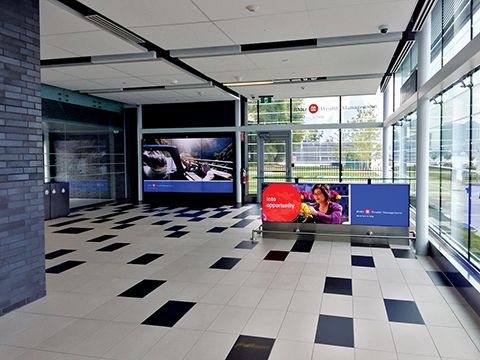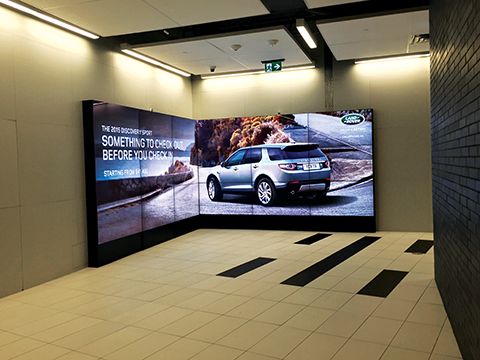Demographics, software and hardware
As mentioned, many BBCTA customers use the facility for short-term business trips. Specifically, research conducted before deploying the DOOH network showed 46 per cent of the airport’s users were frequent business travellers over the age of 45, making more than 10 trips per year, and 37 per cent were mid-career business travellers, mostly aged 35 to 45, who averaged five trips per year. While there were also some younger students and older retirees flying once or twice a year to visit their families, the majority of trips were for business rather than leisure. The overall gender split was 47 per cent male, 53 per cent female.

A double-sided ‘media plinth’ and another video wall in the mainland terminal delineate a special zone for ‘experiential’ marketing campaigns.
Compared to other airports, PortsToronto and Black realized most of BBTCA’s passengers were frequent fliers. This made it all the more important not to inundate them with too many competing messages, but rather continue the ‘less is more’ approach that had made the airport appealing in the first place.
“You don’t want Times Square,” says Black. “If the signs are spaced correctly and do not overwhelm you, you’re more likely to look at them.”
In 2013, Toronto-based software provider Dot2Dot Communications began to help plan the new digital signage network. PortsToronto and Black chose to use its Scala Content Manager and Ad Manager software, along with the Scala Enterprise operating system (OS), to drive the network.
Meanwhile, Gridcast Media of Richmond Hill, Ont., was selected as the hardware integrator for the project. Its team specified a mix of LG liquid crystal displays (LCDs), NanoLumens light-emitting diode (LED) screens and touch-interactive Christie MicroTile display ‘cubes,’ along with media players to run the Scala software.
“By getting involved early enough with Black, Gridcast helped make sure the best mix of hardware and software was established for this particular experience,” says Andy McRae, general manager (GM) of Dot2Dot. “It’s the best-documented process in which we’ve ever been involved. We’re honoured to have played an active role.”
The digital experience
In August 2014, PortsToronto and Black publicly announced details of the overall ‘digital experience’ being developed for BBTCA. They were creating a proprietary smartphone app that would serve as a sort of ‘virtual concierge,’ delivering curated information, original editorial content and ads reflecting the unique demands of each regular passenger, in conjunction with content on nearly 50 digital signage displays throughout a new mainland atrium, the pedestrian tunnel and an island-side atrium, all of which would be completed in 2015.
The goal was for the mobile app to integrate with ad content appearing on screens and video walls along the passengers’ path. Within the tunnel, specifically, eight 9.1 x 0.9-m (30 x 3-ft) multi-screen displays would be installed along the walls, where they would be highly visible whether travellers walked along the pathway or stood on the moving walkways. The screens would also use proximity sensors to trigger content dynamically as people approached and passed them.

Departing passengers can see an L-shaped video wall from several angles, which offers multiple layout options for creative content.
“No one has really integrated an app into a DOOH program like this before, but it makes sense, given most passengers today are on their device all of the time when they’re at an airport and that’s when we want to reach them,” says Black. “The digital experience creates a narrative journey that will extend from the traveller’s home or hotel to the airport curb to the flight gate and beyond to their ultimate destination. Advertisers will be able to target messages that are relevant and pertinent to the individual, ensuring greater levels of retention and awareness.”
With this vision in mind, the app was designed to let users track their flight status, get traffic updates for their trip to the airport, check weather forecasts for both Toronto and their destination, navigate a map of the airport they will land at and even receive localized information about restaurants and events in their destination city. Any such information downloaded in a wireless-fidelity (Wi-Fi) zone could be bookmarked for reading later on the flight, with the mobile device in airplane mode. This combination would make the digital experience useful for passengers, helping them get to their flights on time and offering them a ‘VIP’ experience, regardless of any advertising embedded into the content.
“When you walk into the airport, among the first things you see are the flight information display systems (FIDSs) and the app can tie into those systems for flight status alerts,” says Black. “Going further, the app is designed to support interaction with the ad-based digital signs via texting, beacons, Bluetooth and near field communication (NFC). There are also touch screens in the airport to allow physical interactivity.”
Black cites such potential applications as an automotive advertiser inviting travellers to choose their own style of car on a screen, save the data and then book a real test drive in that model.
“We’re working directly with advertisers to help design interactive content that takes the overall journey into context,” he says. “And because of this airport’s small size and convenient location, it’s one place where people actually have time to interact with ads.”





